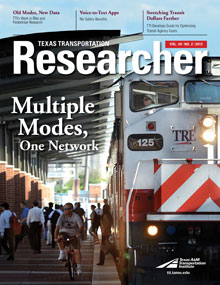Researchers have been perfecting methods for counting cars and trucks for the last half century. As a result of better data, highway transportation has improved, and road projects have been funded. Comparatively speaking, there are very little biking and walking data.

“It’s sometimes difficult for city planners to fund a biking or walking trail project if they don’t have the figures to back it up,” says Shawn Turner, head of the Mobility Division at the Texas A&M Transportation Institute (TTI). “Fortunately, we are getting a lot better at counting pedestrians and bicyclists, and we are trying to help agencies get the data they need.”
Case in point is the national award-winning study headed by TTI Associate Research Engineer Joan Hudson, Using Smartphones to Collect Bicycle Travel Data in Texas. The project, which ended last fall, tracked 300 bicyclists in the Austin, Texas, area as they traveled 3,600 individual routes over a six-month period.
“We were able to collect all kinds of data from this study including age and gender of the bicyclists; preferred travel routes; and frequency, purpose and time of day of the trips,” Hudson explains. “It’s vital information that agencies need in order to make informed decisions about future bicycle projects.”
The study won the 2011 Transportation Innovative Solutions award from Women’s Transportation Seminar International. Data from the GPS-aided study are already being used in other bike projects and have provided assistance to the Texas Department of Transportation (TxDOT) Austin District’s new Bicycle Master Plan.

“Technology has been a major component in our data collection, and as it improves, the information is easier and less expensive to collect,” Turner says. “The bike- and people-counting products range from simple rubber tubes stretched across a roadway or bike path to infrared products and motion-sensing cameras. Some of the products have sensors that are built into a sidewalk or trail.”
The number of bicycle and pedestrian research projects conducted by TTI over the last five years has grown significantly, with a wide variety of sponsors, including the Federal Highway Administration, the National Park Service, the Colorado Department of Transportation, the Austin and Houston metropolitan planning organizations, and the City of Austin.
“With transportation money being tight, we can’t do everything we want to do,” says TxDOT Advanced Transportation Planning Director Ed Collins, who also heads up the development of the Austin District’s Bicycle Master Plan. “We are in the beginning stages of the plan, and I’m not sure what will come from it, but I’m glad that we will soon have a good starting point for establishing a comprehensive network that’ll address the priority mobility needs of bicyclists.”
Turner describes bike and pedestrian research as “in its infancy but growing” and is pleased to see municipalities like Austin, Portland, Seattle, Boulder and numerous others emphasizing those transportation modes where they can provide significant benefits.
“Many cities are recognizing the transportation, public health and economic development benefits of having bikable and walkable cities, and they’re working to create complete streets that provide safe travel for everyone, not just motorists,” Turner says. “I think by 2025, you will see a more diverse landscape as city planners and engineers make room for bicyclists and pedestrians.”
